
The boss’ Countach. The most powerful production Countach was built for the CEO of Lamborghini. Now restored, it has been reunited with famed factory tester Valentino Balboni 30 years on! Mark Wheeler was there. Photography Webb Bland.
PLUS 2 GREAT EXCLUSIVES! Lambo saviour breaks silence Epic 455bhp Countach QV ‘Downdraft’. Company Countach Sant’Agata saviour Patrick Mimran commissioned this very special car.
When the struggling Lamborghini business went bankrupt in 1980, the French Mimran brothers Jean-Claude and Patrick purchased the ailing car company and renamed it Nuova Automobili Ferruccio Lamborghini SpA. Patrick Mimran, a dyed-in-the-wool car-guy back in those days, installed himself at the head of the company and over five years brought it back to life. There were perks, of course, such as treating himself to a brand-new Countach right off the assembly line every few years. The most renowned of these cars was a Quattrovalvole (LP112D), chassis GLA12997.
Mimran had the car commissioned in a one-off colour scheme, a sublime metallic hue dubbed Bordeaux Speciale, specially created by PPG Italver, Lamborghini’s Milan-based paint supplier. Cream leather upholstery named ‘Panna’ plus ‘Oro’ Ozzetta wheels complemented the striking livery. Of course, the boss’ car couldn’t run a stock Tipo L507 V4/73 carburatori engine so unit 1202 was breathed upon, being fitted with special cams and an additional oil cooler. The net result was basically one of the factory blueprinted engines rated good for the 470bhp that the factory afforded its more sporting clients – the extra 15bhp confirmed by then Lamborghini chief technical director ingegnere Luigi Marmiroli. Gearbox 1013 and differential 909 completed the mechanical package. Inside, a state-of-the-art Alpine hi-fi was discreetly installed to satisfy Mimran’s love of music.
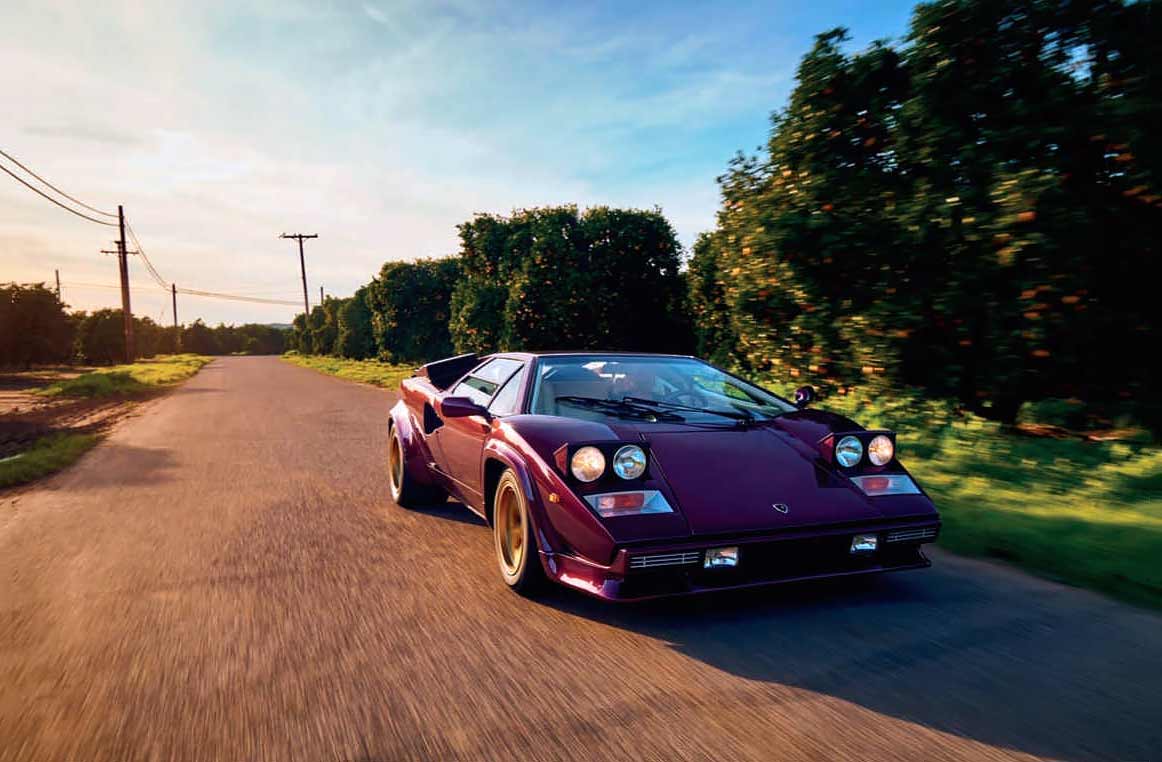
Completed at Sant’Agata on 13 May 1986 for delivery to Switzerland after being signed off by legendary factory tester Valentino Balboni, the Countach was driven out of the factory gates by Mimran on EE (escursionisti esteri) plates for foreign vistitors, and subsequently registered VD.256925 in his Swiss hometown of Vaude. Mimran even kept GLA12997 after he sold his car company to American auto giant Chrysler. The Countach was featured in the December 1986 edition of Road&Track, showing it coming down the factory assembly line prior to finishing. Mimran then used the car on many trips, including memorable ones from Geneva to Sant’Agata, and from Geneva to St Tropez.
It has just been subjected to a full restoration at the hands of US Lamborghini specialist Joe Sackey, who said: “In 2015, I had the opportunity to acquire the car from its second long-term owner in Switzerland. Having owned a dozen examples over the past 25-plus years, I can say without hesitation that this is the most powerful Countach I’ve tried. Just one drive before the restoration is all it took to make me a believer. “While early four-litre versions feel a bit underpowered and stifled by their carburettors, the 5-litre ‘Downdraft’ displays prodigious power from standstill all the way to its terminal velocity. You simply open the throttle as wide as you dare, and you’re rewarded with a smooth delivery of impressive power all the way through the rev range, unlike the earlier cars that tend to hesitate at 2,000-3,000rpm.”
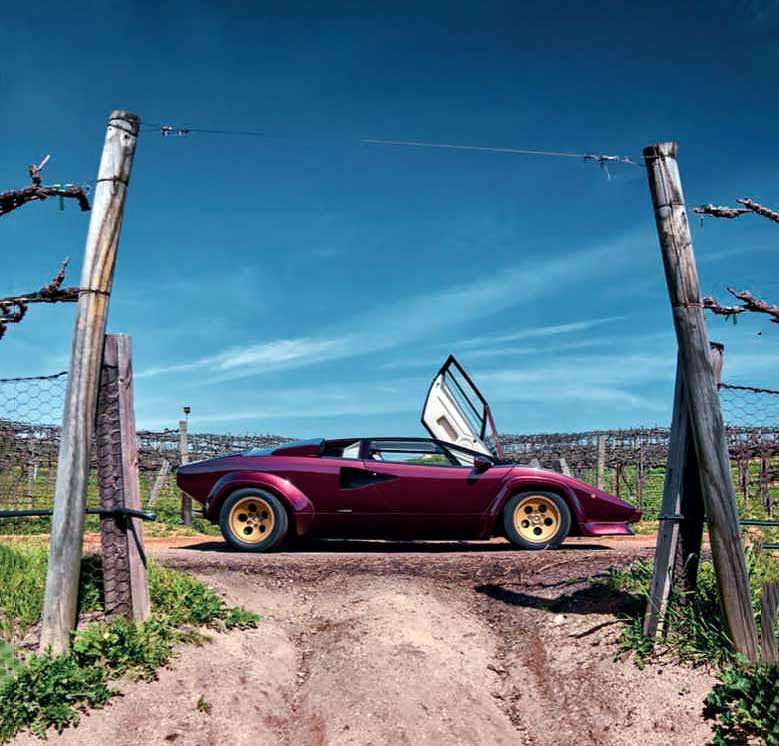
Sackey was initially reluctant to completely disassemble what he deemed to be a fundamentally solid Countach, but with a goal of restoring it to exactly as it left the factory, albeit with improved quality where possible, won out. The rebuild went down to every last copper rivet.
Interior, bodywork, all mechanicals and everything in-between were restored to authentic original and as-new specification, using correct components. Despite being relatively straight, the body went on a rotisserie-type jig for the long process of stripping, priming and sanding. The biggest challenge was precisely matching the beautiful but unique Bordeaux Speciale paint, and it took two attempts, though the results look perfect. The second try was successful thanks to a perfectly preserved panel that yielded an ideal sample for replication. The restoration revealed just how much glassfibre the Countach has attached to its tubular frame, while the front bonnet and engine cover are made of Kevlar, making it the first version of the model to use composite materials there. The entire interior was reupholstered, entrusted to a specialist with almost 20 Countach projects behind him and so capable of replicating the leather, stitching and seams to the original pattern. All mechanical components were refinished or rebuilt as-new.
It was more than a year before the finished car returned to the main workshop, but Sackey was delighted with the results. It was then time to recreate a little bit of history. Some 30 years almost to the day after Lamborghini’s factory tester Valentino Balboni wheeled this very car out of the factory gates and gunned it down Via Modena, he was in California to be reunited with his former flame, and do the honours again. After a day of enjoying the canyon and country roads of the Golden State, he returned with a broad smile: “Perfect.”
Carburetted QVs have earned the moniker ‘Downdraft’, and in recent years have also gained a sort of cult-following, being the most powerful production version of the Countach. For insiders, these are becoming the one to have for other reasons, too. For a start, it was not the early dainty models that adorned countless bedroom walls as much as the wilder, often bewinged versions that so reflected the following decade. Similarly, it was the Downdraft that featured in the 1986 CBS 60 Minutes programme that, in reporting on Lamborghini’s revival, played such a crucial role in the company’s continued success. It served the dual purpose of firstly reminding everyone that the marque still existed and then firmly placed it back in the hearts and minds of American enthusiasts.
The fact that the Downdraft is the only variant that was FIA homologated by the works speaks volumes and is simply the icing on the cake.To the elements of the Countach-hunting community not turned weak at the knees by the word periscopica, this could very well be the Holy Grail of later incarnations. Sackey added: “It’s the only carburetted V12 four-valve engine in a supercar, a true one-of-a-kind, the ultimate Countach.” There are encouraging noises over the engine’s durability, too, with owners reporting that more than 100,000km on an engine is commonplace and 180,000km possible.
It would make a great story to end here, writing a pay-off that, having achieved his ambition of creating the ultimate supercar and knowing that he could not surpass it, Patrick Mimran retired on a high and wandered off, still young, to a life of contentment. Sadly, that just wouldn’t be true because, having restored the company, he actively sought suitors and snared one, multiplying his investment tenfold in the process.
There is no question, however, that both then and now he was very proud of the car we today refer to as the Downdraft. As if it is a part of him. And that may very well be true, in inspiration if not the execution of its creation.
It seems churlish to suggest that any Countach slavishly follows convention, but everything is relative. When you look at this car, there is a brazenness to it, a wildness and confidence that normally stem from youth and inexperience, from those who dare to bend the rules because to them that is still a virtue rather than a sin.
The overall appearance is one of outright aggression with its low lines and wicked stance. Although the bodywork appears to be a series of trapezoidal lines edged by sharp creases, a close look reveals a surprising number of non-straight edges. Whereas the LP400 variant of the Countach is thought to be the purest version, as time moves on and another generation starts to drive the classic car market, there is apparently an increasing fold that feels that the older cars are a little bit anaemic and effete. Indeed, for these youngsters the more wide-wheeled the better, and a carburetted QV hits the mark. Neither do appearances deceive, to pilot the Downdraft is like a bare-knuckle fighter compared to Ferrari’s Gentleman Jim 288GTO, a healthy dose of badassed guitar noise compared to the Ferrari’s edgy but ultimately benign power pop.
And yet it is so unmistakably Countach, so unmistakably Lamborghini in every sinew and every nuance, from the heavy thunk as you drop the scissor door, to the firm inputs and bullying demeanour the driver has to adopt to get the best out of it. As soon as you begin to operate the steering, the pedals and the gearchange you know that this is as much a muscle-man’s car as a muscle car. That said, the payback is performance relative to inputs and a strong but smooth equilibrium is easily divined.
The joy of driving this car properly, listening to the bass-bellow V12 from your reclining position only underscores that so many people who criticised it in period simply didn’t ‘get’ it. What makes the Downdraft truly special is that it offers raw power to go with its looks and a suitably obnoxious cacophophy on the overrun. Perhaps it just confounds people, or they are yet to warm to the OTT charms of the 1980s.
Most of all, however, to get anything out of this car at speed, you need to put a lot in. You must invest, emotionally as well as physically. And that is when it has got you.
‘THE QV DISPLAYS PRODIGIOUS POWER FROM STANDSTILL TO TERMINAL VELOCITY’
‘IT IS LIKE A BAREKNUCKLE FIGHTER COMPARED TO THE GENTLEMAN JIM 288’
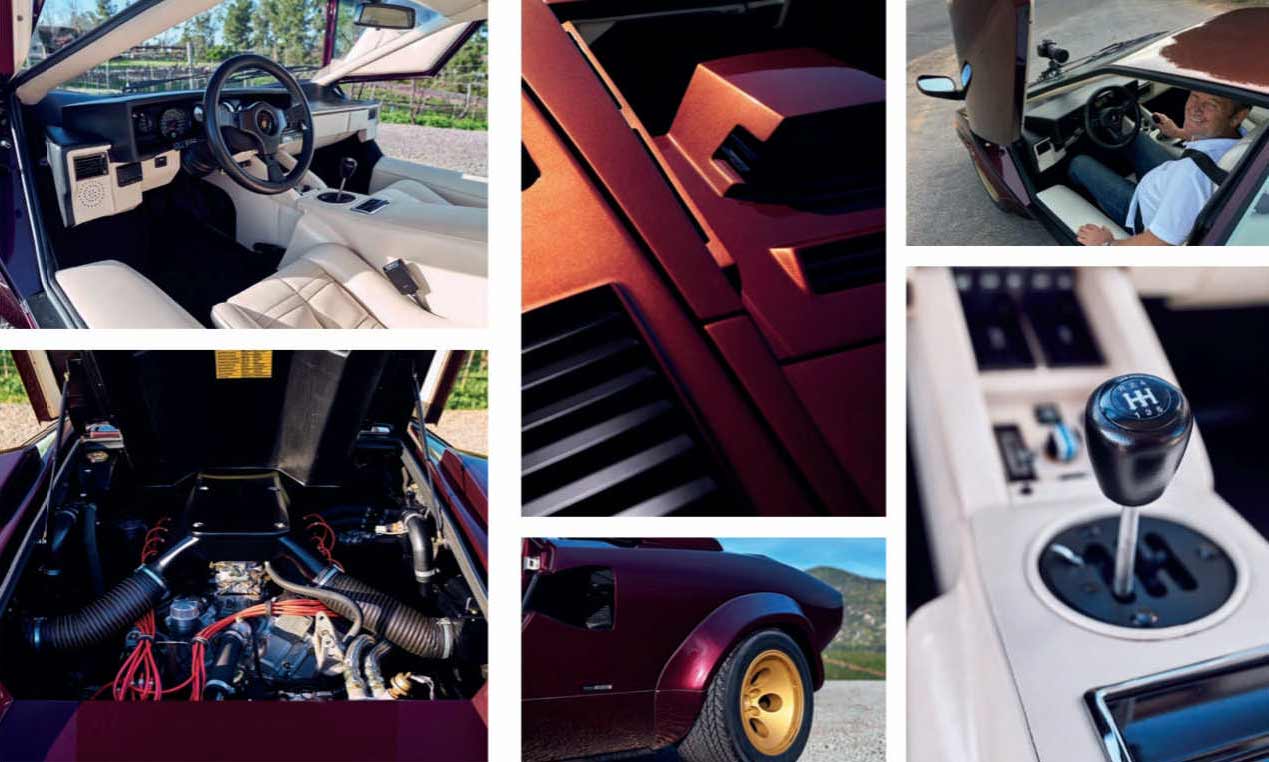
Clockwise: the ‘Downdraft’ offers a far more raw experience on the road; typically opulent – and dazzling – interior offers reclined driving position; four-valve carburetted V12 unique among supercars. The 1980s poster boy’s shape and adornments are more aggressive than the ‘dainty’ LP400. Below: rear 345/35 VR-15s wide enough for you? From top: those doors never age; Balboni’s broad grin says it all after 30-year reunion with the ‘Downdraft’; five speeds enough via open gate.
Patrick Mimran speaks at last
This is the story of the reclusive tycoon who saved Lamborghini before vanishing from the car scene. Automobili Lamborghini SpA went bankrupt in 1980, but struggled on until a young knight in shining armour acquired its interests for just 3,850,000,000 Lire (about $3 million) in May 1981.
The name was changed into Nuova Automobili Ferruccio Lamborghini SpA, and the new boss, 26-year-old Patrick Mimran, set about rebuilding it. He kept Giulio Alfieri on as chief engineer, retained Ubaldo Sgarzi as chief sales manager and drafted in Emil Novarro as operating manager. The company replaced the long-in-the-tooth 4-litre engine with the LP500S in 1982 and the impressive Quattrovalvole in 1985. The LM004 was developed into the marketable LM002, and the Jalpa became a relative success as a smaller-budget sports car. Five years after the takeover, the company had been rejuvenated and the acquisitive Chrysler corporation bought out Mimran for a rumoured £30m in 1987.
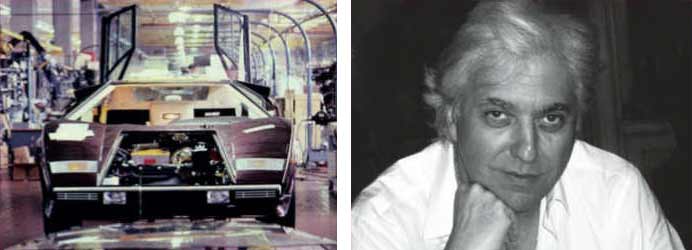
Mimran’s interest in cars waned and, in 1997, he sold his entire collection at Sotheby’s before appearing to sever all ties with the car world as he pursued a life in the arts. When Lamborghini is discussed by enthusiasts nowadays, few acknowledge that if it weren’t for Patrick Mimran, there would be no Lamborghini. Perhaps that is in part due to his nurturing an air of mystery, but specialist Joe Sackey tempted him out of hiding for an exclusive Q&A.
What made you step in to save Lamborghini?
My brother and I thought it was a pity that such a specialised car manufacturer was about to disappear and when we visited the factory and saw how they were building cars, we were even more convinced that we could save it.
Did the Countach inspire your interest?
The Countach was an iconic car, just as the Miura was. When we visited the factory, they were building only three to four Countachs a month. We were sure that it wouldn’t be a problem to increase production.
Howdid you market that increased production?
We expanded our dealer network, which was at that time limited to Switzerland, Italy and France. Crucially, we also formalised our market in the USA – up until that point, the only Lamborghinis sold there were grey imports!
From 1981 to 1983, Countachs were used as pace cars at the Monaco Grand Prix, was this part of the marketing plan?
We did this as a promotion exercise. Many people thought that the company didn’t exist any longer so we had to rebuild confidence among potential buyers, potential distributors, and even parts suppliers. Promoting it at Monaco and trade shows was important.
Who were the key players at Sant’Agata?
Every worker! What I did first was to rebuild confidence and build a firm with a ‘teamwork’ mentality. The work of engineers such as Alfieri and later Marmiroli was crucial, as was the feedback from Balboni. Sometimes I worked alongside them, and I remember being at the factory until 4 or 5am to prepare a prototype Countach for Geneva. It was a very special time.
Was Ferruccio involved during your tenure?
No, by then he had nothing to do with the factory.
How valuable was a test-driver like Balboni?
He was a legend. Keep in mind that we had no test circuit and all testing was done on the narrow roads! What makes Lamborghini so special is the fact that it was the only car company of its type devoted to road cars. The engineers tried so many times to get me into racing and I always refused. I felt that, even if we won races, we could not take this bespoke company beyond its current size, so it would not help us to sell more cars.
By 1985, ingegnere Giulio Alfieri had the Quattrovalvole engine ready – why was this so vital for the Countach?
It was very important for us to give it a more powerful engine. We weren’t bothered about outperforming the Testarossa – Lamborghini had its own customers in those days, quite different from Ferrari customers – but that doesn’t mean we were not pleased to do so!
How did Chrysler come to buy the company?
I went to Detroit to show them (and Ford and GM) a proposal for a front-engined open sports car [which later morphed into the Dodge Viper] using a V10 Lamborghini engine. Chrysler was interested, but wanted 51% of the company. I said the only way I would relinquish control is if they purchased 100%.
Why did you select Bordeaux Metallic Speciale for your 1986 Countach Quattrovalvole?
Bordeaux was a colour I liked, so I asked PPG Milano to come up with something unique for my own car. This was the third and final Countach that I owned, and I kept if for a number of years, even after selling up.
Homologating the Countach QV
From 1982 Group B fostered some of the most powerful and sophisticated rally cars ever built, until the death of Henri Toivonen and co-driver Sergio Cresto on the 1986 Tour de Corse prompted the FIA to ban the class. But whereas the homologation of Ferrari’s 288GTO for Group B is well known, that of the Countach QV came to light only recently.
The Countach in question had six Weber 44DCNF twin-choke carburettors, and is nowadays referred to by enthusiasts simply as the ‘Countach Downdraft’. It is the most powerful production Countach built by Lamborghini in Sant’Agata and the only V12 downdraft carburetted four-valve engine ever put in a sports car.
In 1988, after 200 cars had been produced, the 5167cc Countach QV ‘Downdraft’ (carburetted) was FIA homologated (B291), in the same Group B Class as the 288 GTO (B273). Yet with Group B already outlawed by then, Luigi Marmiroli filed for FIA papers on the basis of a limited run of lightweight cars running in GT1 and GT2.
By then, however, Patrick Mimran had sold out to Chrysler and the idea was shelved in favour of a tilt at F1 involvement. As with the 288 GTO, the Countach Downdraft is a genuine FIA homologation car, and supercar provenance simply does not come any better.
The homologation papers themselves are a treasure-trove of information, recording all aspects of the car’s technical spec, such as gear ratios, output numbers and materials used, all confirmed by an independent entity. While in many aspects the two Italian rivals were ostensibly similar, Ferrari took the of-the-moment F1-inspired twin-turbocharged V8 approach, while Lamborghini stuck with the naturally aspirated V12. The GTO’s 2855cc engine puts out 400bhp, and the Countach’s 5.2-litre unit is rated at 455 bhp, yet performance is about the same.
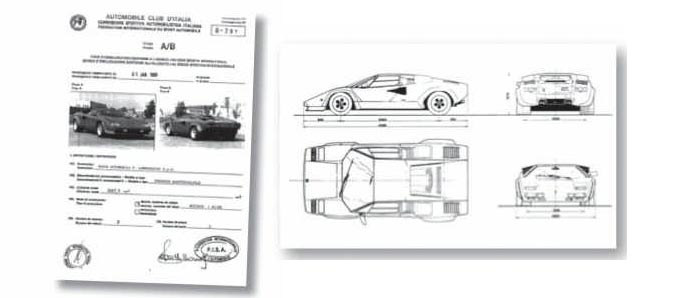
Homologating the Countach QV
The Ferrari and Lamborghini are both 1980s supercar icons despite the GTO being at the beginning of its development while the Countach was at the end of its own, having already been in production for 14 years. Even so, it will be remembered as the most powerful Countach of all, the ultimate variant in many ways. Many now suggest that this type is what the model should have been all along.





